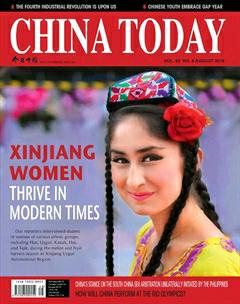Chinese Wisdom of the Belt and Road Initiative
By YAN KUANGZHENG
IN 2013, President Xi Jinping first proposed the initiative of building the Silk Road Economic Belt and the 21st Century Maritime Silk Road. In 2014, China announced that it would invest US $40 billion in the Silk Road Fund. As of now, the Chinese government has been mustering various domestic resources and steeling policy support for the program. The Belt and Road Initiative has been evolving since then from the germ of a great idea to a set of specific measures in full swing.
The author Wang Yiwei is an experienced scholar and diplomatist. In a former role, he was a professor at the Center for American Studies at Fudan University and a diplomat in the Chinese Mission to the European Union. With his rich experience in Sino-Europe and Sino-America relations, he keenly recognizes the initiatives importance. As a scholar from China, a nation that stands fully behind the implementation, execution and success of the Belt and Road Initiative, he believes in the necessity of offering authoritative insights and inviting discussions to guide public opinion both at home and abroad, further advance academic studies, and advocate coordination between industry and academic research. His book, which is replete with intelligent insights and apposite observations, has been written for this end goal.
The book is the first to address the Belt and Road Initiative from the perspective of international relations. Its four chapters all link to its central theme: “What Is the Belt and Road Initiative?”The Opportunities for the World Offered by the Belt and Road Initiative; the Given Risks of the Belt and Road Initiative and Ways to Advance the Belt and Road Construction are also fully addressed in great depth as separate chapters.
The book, moreover, presents a rejoinder to biased opinions prevalent in the world, against such voices that the Belt and Road Initiative is “Chinas Marshall Plan.” In comparison with similar programs in the past, the Belt and Road Initiative has evinced an improvement in its historical antecedents, in its intent, core content and the manner of its implementation.
The initiative gets in gear against the background of a new situation in the post-financial crisis era. It turns its eye to developing nations and seeks to co-opt the historical iconography of the ancient Silk Road in order to work with other countries to build a communality of common interest, shared future, and shared responsibility that features political mutual trust, economic integration, and cultural inclusiveness.
The author, to his credit, is no less explicit in pointing out the risks. He admits and underscores that great undertakings necessarily involve some risk. The Belt and Road Initiative will touch on political hotspots, including the Middle East, so the possibility that armed internal conflicts there may threaten such countries participation and slow construction of Belt and Road projects is far from remote. The Belt and Road stretches over the vast Eurasian continent, with its massively diverse natural conditions. These geographical characteristics consequently spawn diverse natural and environmental risks.
At present, the global economic recovery is on an upward trajectory, whereas the economic growth trend for developed economies and emerging market countries is sharply diverging. Shrinking global trade will affect the growth of countries along the Belt and Road, as will reduced direct overseas investment, fluctuations in bulk commodity prices, deficient energy supplies, and weakened currencies.
The Belt and Road Initiative involves over 60 nations whose legal systems are vastly different from Chinas. Furthermore, monopoly and unfair competition, credit default, contract fraud, and dumping and trade subsidies might all engender ethical risks for the Belt and Road Initiative.
As a result, the implementation of the Belt and Road Initiative will confront considerable obstacles. The author illustrates that, to overcome these obstacles, attaining multi-win cooperation, openness, inclusion and balanced development are essential ingredients for international cooperation in the 21st century. To realize infrastructure connectivity, free trade flow, financing agreements, policy communication and friendly exchanges between peoples in the Belt and Road region, as proposed by President Xi Jinping, specific measures such as provision of loans, tariff reductions, talent cultivation, aid increases and debt forgiveness will all have to come into play. The only way to clear all the obstacles and to dissipate doubts and detractions about the initiative is to achieve success with the Belt and Road.
The Chinese edition of this book has won the “Great Books of China 2015” award, among other plaudits. The English-language edition launched in February in China. In Britain, its publication launch ceremony held in April was a smashing success. Upon his return to China, the author began to further address this weighty theme in such works as Ten Questions Regarding the Belt and Road Initiative, The World Is Interconnected, and The Silk Road in Cartoons, all written from the perspective of reinvigorated theoretical and practical knowledge, and all casting out to net a wider audience. For the strength and quality of his work, the author has earned the sobriquet “Mr. Belt and Road.”
The Belt and Road stands as a grand mural. Several human generations from dozens of countries will be the artists who come together to emblazon it. By seizing the earliest opportunity to correct and calm misgivings about the initiative, the book brushes the Belt and Road in colorful, deep and insightful strokes.

